Fixed
There’s no such thing an everyday case to your patients, so we approach even single-unit cases with an attention to detail that ensures our restorations meet everyone’s expectations. From traditional solutions to CAD/CAM all-ceramics, One Perma-Dent is here to make you confident in your restorative work and your patients confident in their smiles.
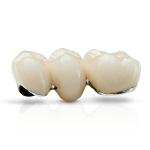
PFM
The longtime favorite ceramic restoration, our porcelain fused to metal features highly esthetic porcelain hand-layered onto a coping cast from your choice of alloy. Preserve more of the natural tooth or prescribe when space is limited because of alloy’s superior strength.
Our PFMs can be used for crowns and bridges (up to fourteen units). PFMs can be manufactured to non-precious, semi-precious, and yellow high noble copings and can be used in conjunction with cast partials and implants.
Contraindicated when the patient has a metal allergy or when the size of the tooth pulp is negligibly smaller thus compromising the tooth preparation process. It is also contraindicated when the clinical tooth crown is very short and lacks the required stability including retention that is enough to provide the space for porcelain and metal.
The ideal preparation for PFMs is a chamfer margin preparation. If a porcelain labial margin is prescribed, then a shoulder margin preparation is required.
Feather-edge margin preparations are indicated for full-cast restorations.
- Panavia 21 – tin plated
- Glass ionomer cement (GC Fuji, GC America)
- Zinc Phosphate Polycarboxylate
- Resin Ionomer cement (RelyX, 3M ESPE)
If an adjustment is required on the ceramic, use a fine diamond with water and air to keep the crown cool.
To contour the ceramic, polish with a pink rubber wheel and diamond polishing paste (Brasseler, Shofu, Vident).
- D2750 Crown Porcelain fused to high noble
- D2751 Crown Porcelain fused to non-precious
- D2752 Crown Porcelain fused to semi-precious
- D6750 Crown Porcelain fused to high noble (bridge units)
- D6751 Crown Porcelain fused to non-precious (bridge units)
- D6752 Crown Porcelain fused to semi-precious (bridge units).
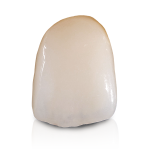
IPS e.max®
Achieve results so lifelike they’re suitable for restorations in the facial zone with IPS e.max®. Lithium disilicate restorations provide the most natural shading and translucency, and, when accurately matched to stumpf shades, offer highly esthetic restorations. Pressed to assure the highest esthetics, e.max restorations offer superior durability – up to 400 MPa average flexural strength – when compared to feldspathic porcelain.
IPS e.max press is indicated for full anterior or posterior crowns, veneers, inlays, onlays,as well as three-unit bridges having only one pontic with the second bicuspid as the most distal abutment.
Bridges which include molars, Maryland style bridges and bridges which have a short vertical height that does not allow for adequate connector height.
Anterior full-coverage crowns require a chamfer or shoulder margin. A circular shoulder is prepared with rounded inner edges or a chamfer at an angle of 10-30°: the width of the shoulder/chamfer is approx. 1 mm. Facial reduction is 1.5 – 2 mm; 1 – 1.5 mm lingual contact clearance. Incisal reduction is 1.5 – 2 mm with rounded internal line angles, and an incisal edge at least 1mm wide to permit optimum milling of the incisal edge during CAD/CAM processing.
Posterior full-coverage crown requires a chamfer or shoulder margin. A circular shoulder is prepared with rounded inner edges or a chamfer at an angle of 10-30°: the width of the shoulder/chamfer is approx. 1 mm. Occlusal reduction is 1.5 – 2 mm: axial reduction (buccal, lingual and interproximal) is 1.5 mm with rounded internal line angles.
IPS e.max layered – can be either cemented using a resin reinforced glass ionimer such as Relyx Luting cement. Or bonded using a resin cement, when extra strength is needed due to lack of retention on the prep, use a resin cement such as Relyx Unicem or Relyx Ultimate.
If adjustments are needed, use fine diamonds with water and light pressure. Always remove the crown when adjusting or bond/cement crown before adjustments are made.).
- D2740 Crown
- D2610 Inlay for 1 surface
- D2620 Inlay for 2 surfaces
- D2630 Inlay for 3 surfaces
- D2962 Labial Veneer
- D2783 Crown 3/4 Porcelain Ceramic (does not include veneers)
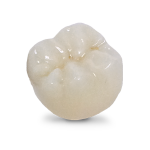
Full-Contour Zirconia
With flexural strengths that exceed 1,200 MPa, full-contour zirconia is the most durable ceramic option available. Available in all 16 Classical Vita® shades for a full range of esthetic options, it’s CAD/CAM fabricated for the most precise fit availab.e Because it’s more forgiving on opposing dentition than conventional porcelain, it’s the ideal all-ceramic solution for bruxing patients.
Full-contour zirconia is so versatile, it can be used in almost any situation from singles, bridges with any combination of abutments and pontics, inlay bridges, Maryland type bridges and screw retained implants. Also an esthetic alternative to a PFM with metal occlusion due to limited space.
Contraindications include:
- When esthetic expectations are high and it is important that the restorations match surrounding natural dentition or other existing restorations
- If bonding is necessary to retain the restoration, bond strength is weaker and less predictable than other ceramics
Shoulder preparation not needed. A mild champfer or a feather edge margin is good. 1mm buccal, lingual and occlusal reduction is ideal, but can go to .5mm in some areas, when reduction is limited.
Minimum occlusal reduction of 0.5 mm; 1 mm is ideal.
Adjustments and polishing: Adjust Full-contour zirconia zirconia crowns and bridges using water and air spray to keep the restoration cool and to avoid micro-fractures with a fine grit diamond. If using air only, use the lightest touch possible when making adjustments. A football shaped bur is the most effective for occlusal and lingual surfaces (on anterior teeth); a tapered bur is the ideal choice for buccal and lingual surfaces.
Polish Full-contour zirconia restorations with the porcelain polishing system of your choice.
Full-contour zirconia may be cemented using a resin reinforced glass ionomer such as Relyx Luting cement. When a greater bond is needed do to the lack of a retentive preparation, use resin cement like Relyx Unicam or Relyx Ultimate.
Before cementing all Full-contour zirconia zirconia crowns, the interior serface of the corwn needs to be cleaned with Ivoclean (Ivoclar Vivadent;Amherst N.Y.). This is critical in assuring maximum bond strength.
Solid zirconia requires a cast gold type preparation.
If adjustments are needed, use zirconia specific diamonds and rubber wheels polishing with diamond paste.
HDS has zirconia adjustment kits available.
- D2740 Crown – Porcelain/Ceramic Substrate
- D6245 Pontic Porcelain/Ceramic
- D6740 Abutment Crown Porcelain/Ceramic
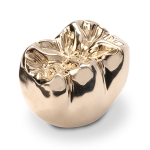
Full Gold Crown
The traditional restoration is still a viable solution in many cases where clearance is limited and esthetics aren’t a major factor. The most biocompatible material available, cast crowns are resistant to plaque and bacterial buildup, while being extremely gentle on opposing enamel.
Full-contour zirconia is so versatile, it can be used in almost any situation from singles, bridges with any combination of abutments and pontics, inlay bridges, Maryland type bridges and screw retained implants. Also an esthetic alternative to a PFM with metal occlusion due to limited space.
Contraindications include:
- When esthetic expectations are high and it is important that the restorations match surrounding natural dentition or other existing restorations
- If bonding is necessary to retain the restoration, bond strength is weaker and less predictable than other ceramics
Shoulder preparation not needed. A mild champfer or a feather edge margin is good. 1mm buccal, lingual and occlusal reduction is ideal, but can go to .5mm in some areas, when reduction is limited.
Minimum occlusal reduction of 0.5 mm; 1 mm is ideal.
Adjustments and polishing: Adjust Full-contour zirconia zirconia crowns and bridges using water and air spray to keep the restoration cool and to avoid micro-fractures with a fine grit diamond. If using air only, use the lightest touch possible when making adjustments. A football shaped bur is the most effective for occlusal and lingual surfaces (on anterior teeth); a tapered bur is the ideal choice for buccal and lingual surfaces.
Polish Full-contour zirconia restorations with the porcelain polishing system of your choice.
Full-contour zirconia may be cemented using a resin reinforced glass ionomer such as Relyx Luting cement. When a greater bond is needed do to the lack of a retentive preparation, use resin cement like Relyx Unicam or Relyx Ultimate.
Before cementing all Full-contour zirconia zirconia crowns, the interior serface of the corwn needs to be cleaned with Ivoclean (Ivoclar Vivadent;Amherst N.Y.). This is critical in assuring maximum bond strength.
Solid zirconia requires a cast gold type preparation.
If adjustments are needed, use zirconia specific diamonds and rubber wheels polishing with diamond paste.
HDS has zirconia adjustment kits available.
- D2740 Crown – Porcelain/Ceramic Substrate
- D6245 Pontic Porcelain/Ceramic
- D6740 Abutment Crown Porcelain/Ceramic
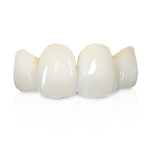
Veneers
Improve smile esthetics while preserving most of the natural enamel with veneers from One Perma-Dent studio. From smile design to cosmetic touch-ups, our veneers are fabricated as thinly as possible to preserve enamel and make bonding easy.
Veneers can be used for cosmetic correction for conditions including chipped teeth, discoloration, hypocalcification, malposed teeth and multiple diastemas.
Veneers are contraindicated when the patient has insufficient enamel for bonding, excessive space between teeth, a history of bruxism or poor oral hygiene.
Use a tapered diamond to reduce labial tooth structure to proscribed depth. Create a 0.5 mm chamfer edge to prevent movement.
Any high-translucency resin cement is appropriate to bond a porcelain veneer, although dual-cured resin with amin co-initiators may cause a yellowing effect with age.
Before cementation, clean the prepared tooth with an oil- and fluoride-free pumice to remove any contaminants.
D2961 Labial veneer (resin laminate)

PMMA Temporaries
Give your patients the perfect smile even as they wait for their final restoration with PMMA temporaries from One Perma-Dent. Fabricated from the same design files we use to create the final restoration, PMMA temporaries provide reliable function and esthetics for up to six months.
PMMA temporaries are indicated for provisional, splinted full-arch crown when pontic span is less than 3 units. Provisional restorations should not be seated for more than six months.
Provisional restorations with pontic span greater than three units.
Use existing preparation for final restoration.
TempBond (NE) (Kerr)
Proviscell (Septodont)
Provolink (Ivoclar)
Roughen temps with pumice.
Rinse and dry with air.
Apply a thin layer of palaseal going in one direction.
Bench dry for 20 seconds (air dry).
Polymerize for 90 seconds with hand held curing unit (a light box works best, but hand held light can be used with 2 cycles of 90 seconds on each surface).
D2799 Provisional crown
Products
Fixed
Implants
Hybrids
Removables
One Perma-Dent Studio
1 Rockefeller Plaza #2210
New York, NY 10020
Office: 212-757-5430
Fax: 212.757.5477


